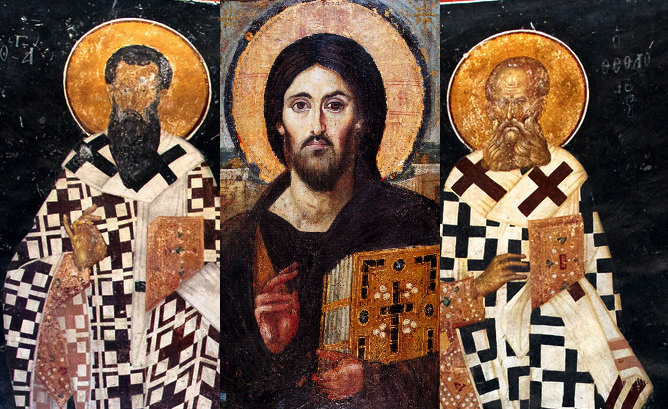The New Year celebrations are over, but the Twelve Days of Christmas continue. Yesterday, January 2nd, was the Ninth Day of Christmas. It is associated with nine ladies dancing in the song, but also with two very serious-minded Doctors of the Church in the Christmastide calendar.
Saint Basil the Great, Bishop of Caesarea, and Saint Gregory of Nazianzus, Patriarch of Constantinople, were titans of the Patristic Age of Christianity, both from Cappadocia in Asia Minor, when it was still an ethnically and culturally Greek space rather than a Turkish one.
The pair are greatly reverenced in the Greek Orthodox and wider Eastern Orthodox Church — where with St. John Chrysostom they are venerated as the Three Holy Hierarchs — though the Orthodox honor them on different dates, according to their own calendar (St. Basil on January 1st and St. Gregory on January 25th). They are also honored by Roman Catholics, however, having lived in the fourth century, hundreds of years before the Great Schism separated Catholicism and Orthodoxy.
THEOLOGY MEETS PHILANTHROPY.
The pair share a feast day in part because they were great friends, with St. Basil ordaining St. Gregory a bishop and St. Gregory delivering St. Basil’s epic funeral oration after he passed away.
Their patristic writings, while sometimes difficult to unpack for the layman, remain required reading for serious theologians seventeen centuries after their time. Both were staunch defenders of Nicene Christianity against Arianism, a heresy that earned its originator a slap from Santa Claus – another Greek.
Arius and his followers argued against the Trinity, as modern Christians understand it, and regarded the Son as a creature of the Father. St. Basil and St. Gregory defended both the divinity and the humanity of Christ, and refuted heretics who denied the place of the Holy Spirit within the Godhead as well.
They were not just great theologians, however. St. Basil, in particular, was a great builder of almshouses, hospitals, hospices, orphanages, and soup kitchens. He is believed to have given all of his personal wealth away to this endeavor, establishing an enormous complex of charitable institutions beyond his city’s walls, dubbed the Basiliad.
The Ninth Day of Christmas, then, may not just be a day to dip into their patristic writings and try to deepen our understanding of the faith, but to remember the commandment to do unto others as you would have them do unto you – and perhaps arrange to put in a shift at the local soup kitchen.
BACK TO JESUS.
Today is January 3rd – the home stretch; the antepenultimate celebration in the Twelve Days of Christmas. The Tenth Day of Christmas is a day that brings us back, after our detours into Plantagenet England and 4th-century Greece, to the true reason for the season: the Son of God, and the Feast of the Holy Name of Jesus.
It was the Archangel Gabriel who told St. Mary, whose solemnity was celebrated on January 1st, to “Fear not,” for “thou hast found favor with God. And, behold, thou shalt conceive in thy womb, and bring forth a son, and shalt call his name Jesus.”
The name Jesus means ‘God is salvation,’ or ‘God saves,’ and is believed to express both the identity and the mission of its bearer.
It is a powerful name, with St. Paul writing in his epistles that it is “a name which is above every name,” and that “at the name of Jesus every knee should bow” and “every tongue should confess that Jesus Christ is Lord, to the glory of God the Father.”
In the past, it was customary for Christians to offer a slight bow of the head on hearing or uttering the name of Jesus, as a mark of respect and reverence. The Feast of the Holy of Name of Jesus is a time when traditionalists often call for this custom to be revived, comparing it to the respect Muslims show for their prophet by following every utterance of his name with “peace be upon him.”
WHAT ABOUT THE CAROL?
In the famous and slightly interminable 18th-century carol, we find ourselves coming close to the end of the long list of Christmas gifts, with things having started to get a little ridiculous from the Eighth Day onwards:
On the tenth day of Christmas,my true love gave to meTen lords a-leaping,Nine ladies dancing,Eight maids a-milking,Seven swans a-swimming,Six geese a-laying,Five golden rings,Four calling birds,Three French hens,Two turtle doves,And a partridge in a pear tree.
The symbolism was actually fairly clear to our Christian forebears, however: lords, historically, served as judges in the manor courts of their estates, upholding the law. The lords a-leaping in the song, therefore, were intended to represent the Ten Commandments – rather less obscure, if you can believe it, than the dancing ladies of the Ninth Day of Christmas, who represent the nine fruits of the Holy Spirit referred to in the Epistle to the Galatians.
More on all of that another time.


